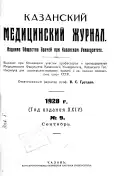On the application of the Manoilov reaction to determine the sex of the intrauterine fetus.
- Authors: Chigarin A.P.1
-
Affiliations:
- Obstetrics and Gynecology Clinic, Kazan State University
- Issue: Vol 24, No 9 (1928)
- Pages: 887-895
- Section: Articles
- URL: https://journals.rcsi.science/kazanmedj/article/view/91195
- DOI: https://doi.org/10.17816/kazmj91195
- ID: 91195
Cite item
Full Text
Abstract
Sexual dimorphism has been an extremely important and interesting problem of biology for the last 25 years. The discovery by Mac Kleen and Wilson (in 1905 ) of the x-chromosome and the quantitative difference between chromosomes in the egg cell and sperm cell of the bug Anesa tristis, which produce an even or odd combination during copulation and predetermine further development of a female (22 chromosomes) or a male (21 chromosomes), discovery by Wichardt of the possibility to distinguish human blood from that of great apes by cross immunization, as well as male blood from female blood, at a high degree of their dilution, the known difference between male and female blood in the number of red blood cells (Nägeli), their sedimentation (Faerheus) and viscosity (Determan), in Ph and the content of protein and colloidal substances, i.e., in the biochemical composition of blood cells. ie biochemical composition, as well as the total amount of blood (Rattman) - all these facts confirm that the male body is biologically sharply different from the female. At the same time, works of recent years in the field of endocrinology definitely indicate that the marked difference depends on the endocrine glands and mainly on the sex glands (Voronov, Steinach, Zavadovsky, etc.), whose hormones enter the blood. The latter, as a transmitter of everything that happens in the body, reflects as a mirror all the smallest changes in it, which is confirmed daily by clinical and experimental evidence. In particular, pregnancy in a woman, causing various changes in the whole organism, among other things, leads to a number of changes in the blood, and among these changes we can expect to find such, which depend on the function of fetal glands.
Keywords
Full Text
##article.viewOnOriginalSite##About the authors
A. P. Chigarin
Obstetrics and Gynecology Clinic, Kazan State University
Author for correspondence.
Email: info@eco-vector.com
Russian Federation
References
Supplementary files





